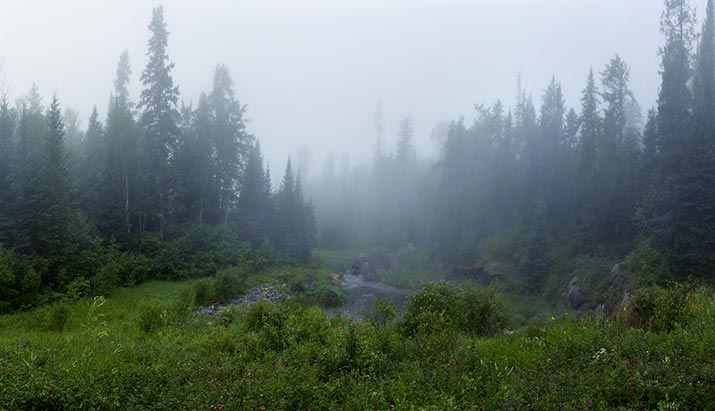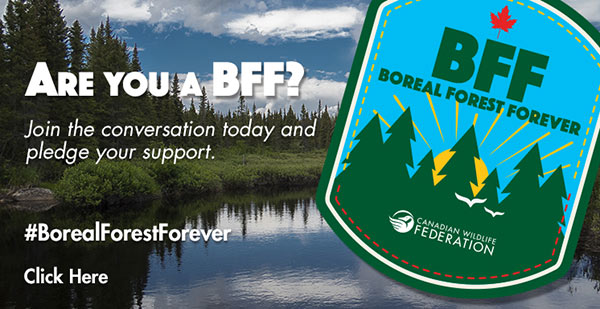Project Overview
Canada’s western boreal forest is a region of national and international interest due to its immense economic and ecological values. The region’s oil, natural gas, timber, arable land, and minerals are all sources of great economic potential, but they also carry risks to wildlife and their habitat due to the cumulative effects of dispersed and often overlapping impacts of resource development. Oil and gas extraction in the area has drawn a great deal of national and international attention due to its large carbon footprint, particularly the oil sands; however, carbon emissions are only part of the story. The next 50 years of development of multiple, overlapping resources will also change the forests, wetlands, streams and rivers with consequences for wildlife and ecosystem services in the region an area three times the size of the United Kingdom.
The Canadian Wildlife Federation conducted a simulation of the benefits and liabilities of the next 50 years of development in the western boreal to inform a national dialogue on the options for wildlife conservation in this rapidly developing region. The ultimate goal is to create a comprehensive land-use plan for wildlife conservation and resource extraction in the western boreal forest.
Key Findings for Next 50 Years of Development:
We looked at future scenarios for wildlife, the environment, and the economy under three different economic growth rates. We also considered improved industry best practices and zoning large portions of the landscape for wildlife conservation. Overall our simulations of business-as-usual development found the following:
- Status quo, business as usual development results in habitat loss and alteration across a huge area of boreal forest with significant short and long term impacts on wildlife and the environment.
- Improving industry best practices slows but does not stop the decline of wildlife habitat over the next 50 years. Such actions alone would likely be insufficient to maintain current populations or reverse current declines.
- Boreal caribou require special attention and immediate decisions and actions if they are to remain on portions of the landscape at self-sustaining levels.
- The potential economic value of natural resources in the region is immense, and foregoing a portion of this resource potential in order to benefit wildlife and the environment would still result in massive economic benefit to Canada.
- Conservation zoning and protected area planning that considers the trade-offs between conservation and economic development is critical to maintaining extensive areas with low to moderate risk for sensitive wildlife populations of birds, caribou, recreational fish, or old forest specialists such as fisher. The acceptable level of trade-off between natural resource development and wildlife conservation is an important question for society to answer.
Our Forests
- Forests become younger in response to forestry activity and fire. As a result, old forest adapted wildlife are impacted and the capacity of the boreal forest to store carbon declines by millions of tonnes.
- The loss of forest to development such as roads, well sites, mines, pipelines, farms, and settlements grows by over 12,000 km2, an increase of 24 per cent.
Our Wildlife
- Forest disturbance from industrial development puts boreal caribou at high risk across most of the region, suggesting population declines and possible loss from large areas. Industry best practices are unlikely to significantly improve the outcome.
- The habitat for songbirds that prefer old forest declines in the south where forestry is more intensive. In the north, habitat increases over time.
- Risk to fisher increases from low to moderate due to declining older forest and expanding industrial footprint.
- Moose benefit as they prefer new growth forest.
- Recreational fishing in the southern half of the region shifts to lower catch rates, smaller fish, and loss of some species from the fishery largely due to increased exploitation, but also due to impacts of culverts and roads.
Our Environment
- Approximately 12.4 million tonnes of carbon (6.5per cent of Canada’s annual emissions) is lost annually from the forests of the region.
- By 2020, greenhouse gas emissions from the region accounts for 22 per cent of Canada’s commitment under the Copenhagen accord and increases significantly in future years. A reduction in emission intensity of 50 per cent is likely necessary to stabilize total emissions at 2020 levels.
- Sulphur emissions are predicted to triple over the 50 years with total emissions of over 420,000 tonnes annually in the oil sands area with the possible risk of acidifying some lakes in the region.
Did You Know?
- Of all the economic activity in the region, the oil sands is by far the primary source of revenue and jobs but also has the most intensive environmental impacts. On the other hand, forestry, agriculture, and other types of oil and gas development alter the largest area of habitat.
- Human population in the region is expected to almost double from 440,000 to just under 800,000.
Take the Boreal Forest Forever Pledge!
The Western Boreal Forest plays a critical role in absorbing and storing greenhouse gases which help mitigate the impacts of climate change. Canada needs a comprehensive solution for sustainable use of our natural resources, maintaining the boreal forest’s role in storing carbon, and conserving the wildlife that call the forest home. I support the need to have an open dialogue about the future of the Western Boreal Forest and the Canadian Wildlife Federation’s dedication to meet this challenge. #BorealForestForever
Download the Western Boreal Forest Report
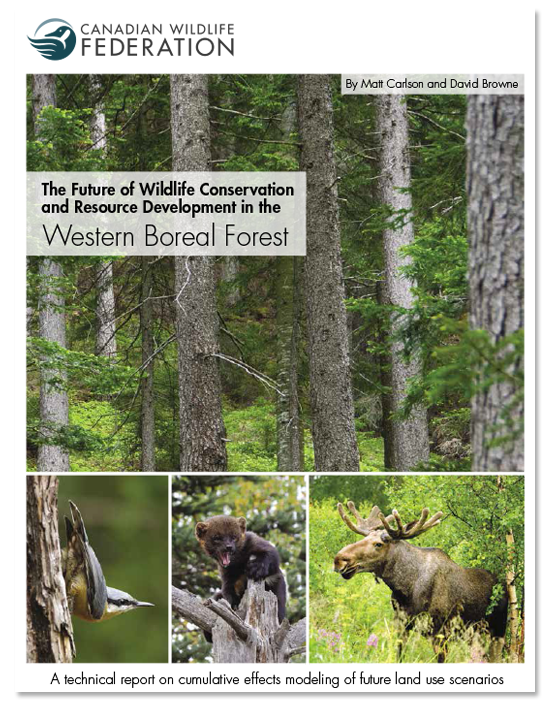
*First Name:
*Last Name:
Organization:
*Postal Code/ZIP
*E-mail:
I would like to receive CWF's free e-newsletter.
Please add me to CWF's online community. I will receive wildlife and conservation updates, the latest news and features, opportunities to support CWF’s mission and special CWF and partner e-mail offers for free! I know that I can unsubscribe at any time.
Support the Boreal: Adopt an Animal!

Your adoption of a moose will help CWF conserve at-risk areas like the boreal forest and others in Canada.
Example of Findings
Greenhouse Gas Emissions

Industrial greenhouse gas (GHG) emissions during simulations of low, moderate, and high development rate, and under moderate development rate with best practices, specifically, 50 per cent reduction in GHG emissions intensity of bitumen sector.
Tradeoff between economic development and risk to wildlife
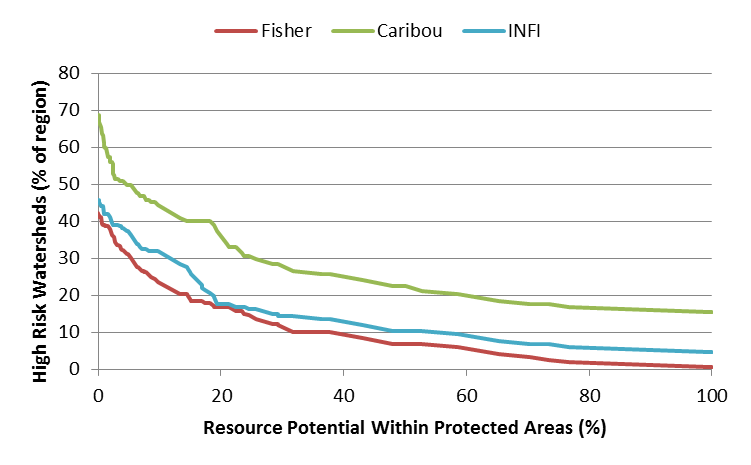
Proportion of the study area covered by watersheds assessed as high risk for fisher, caribou and the index of native fish integrity (INFI) under a range of levels of protection. The range of protection levels was created by successively selecting watersheds for conservation zoning in order of increasing economic cost of avoided disturbance.
Forest age in 2010 and 2060



Songbird habitat in 2010 and 2060
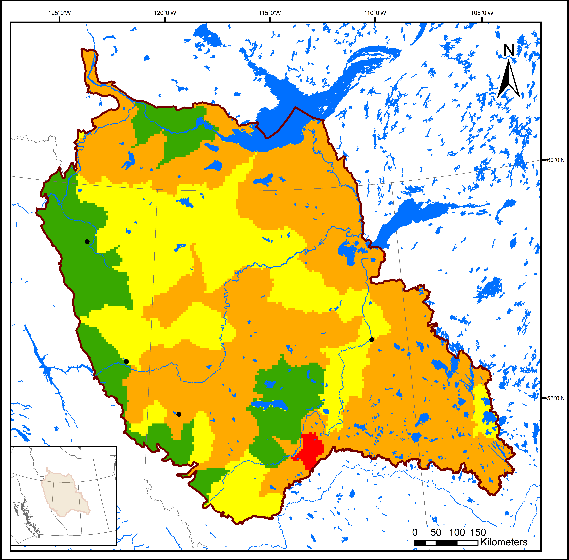


Fisher habitat in 2010 and 2060
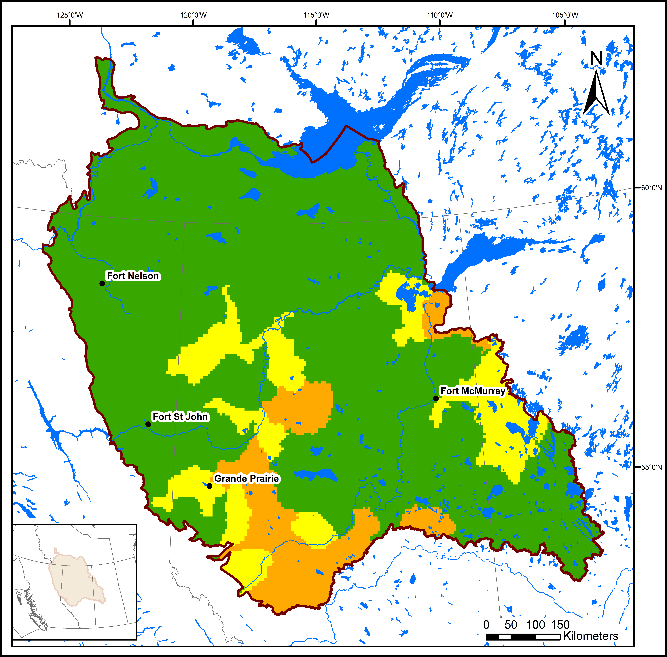
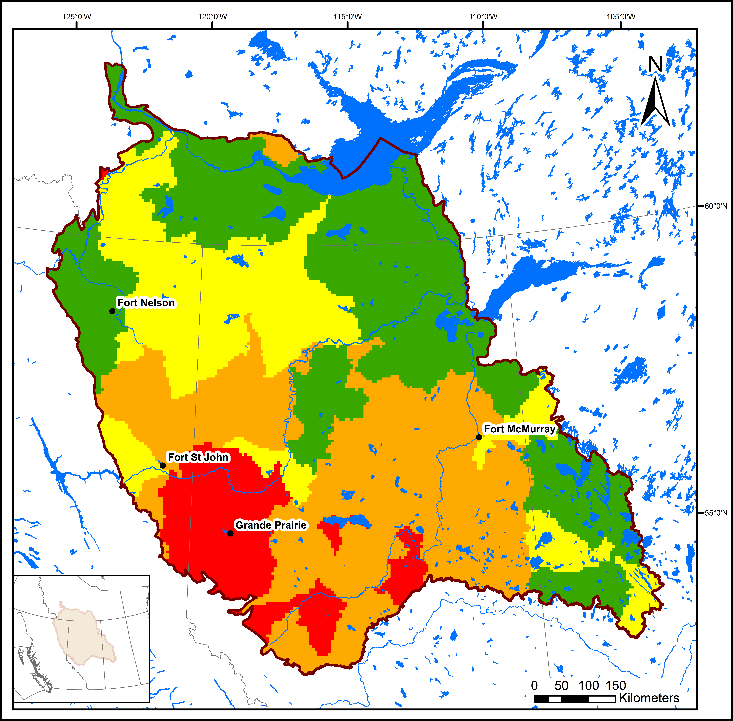

Simulated fisher habitat risk index under the business as usual scenario with moderate development rate.
Boreal caribou population status in 2010 and 2060
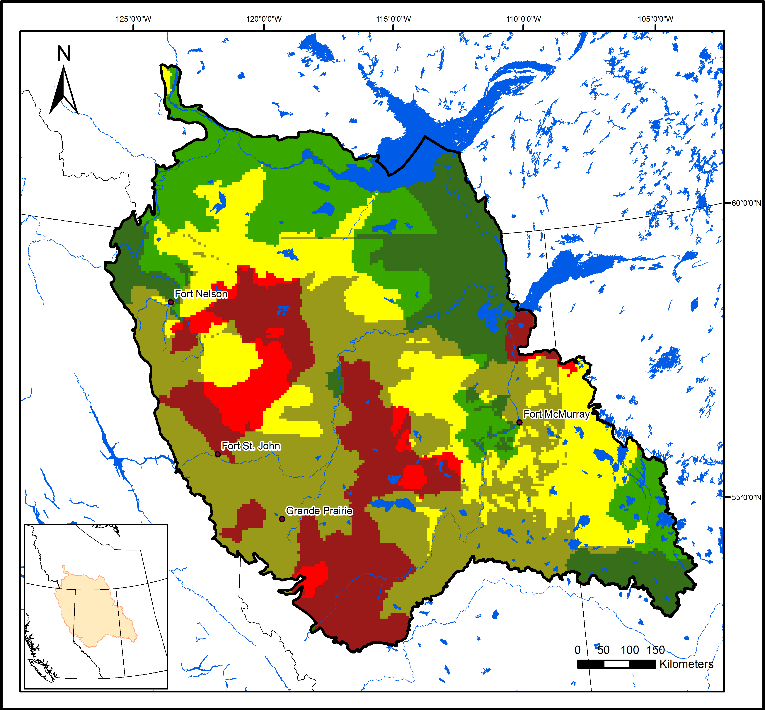


Simulated boreal caribou population growth index under the business as usual scenario with moderate development rate. Shaded areas indicate portions of the study area where caribou do not occur and habitat is not suitable.
